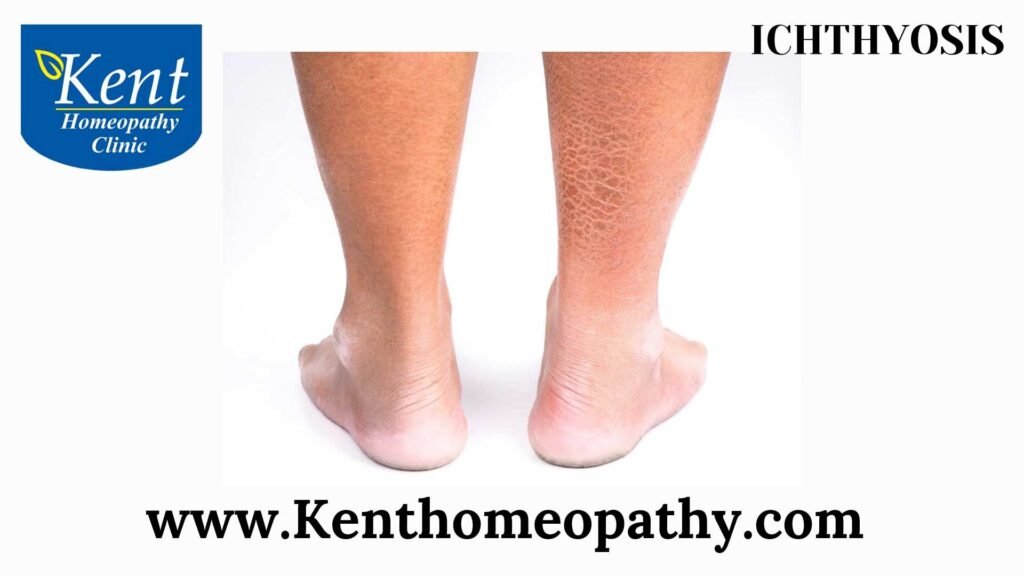Ichthyosis

Ichthyosis refers to a group of genetic skin disorders characterized by dry, scaly skin. These conditions result from a dysfunction in the skin’s natural shedding process, leading to the accumulation of skin cells. Here’s an overview of ichthyosis, including its symptoms, causes, and types:
Symptoms of Ichthyosis:
- Dry, Scaly Skin:
– The hallmark symptom of ichthyosis is the presence of dry, scaly skin. The scales may range from fine to thick, and their appearance can vary depending on the specific type of ichthyosis.
- Itching:
– Many individuals with ichthyosis experience itching, which can be mild to severe and may contribute to skin irritation.
- Cracked Skin:
– The skin affected by ichthyosis is prone to cracking, especially in areas that experience friction or pressure.
- Redness:
– The affected skin may appear red or inflamed due to the dryness and scaling.
- Pain and Discomfort:
– In severe cases, ichthyosis can cause pain and discomfort, especially if the skin becomes tight and rigid.
- Restricted Movement:
– In some forms of ichthyosis, the skin’s tightness and scaling can limit joint movement and flexibility.
- Increased Susceptibility to Infections:
– The compromised skin barrier in ichthyosis can make individuals more prone to skin infections.
- Eye Involvement:
– In some types, the scales may extend to the eyelids and cause irritation or restrict eye movement.
Causes of Ichthyosis:
- Genetic Mutations:
– The majority of ichthyosis cases are inherited and result from genetic mutations. The specific genes involved vary depending on the type of ichthyosis.
- Autosomal Dominant Inheritance:
– Some types of ichthyosis follow an autosomal dominant pattern, meaning an affected individual has a 50% chance of passing the condition to their offspring.
- Autosomal Recessive Inheritance:
– Other types are inherited in an autosomal recessive manner, requiring both parents to carry the mutated gene for a child to be affected.
- Acquired Ichthyosis:
– While rare, ichthyosis can develop later in life due to certain medical conditions, such as hypothyroidism, lymphoma, or the use of certain medications.
Types of Ichthyosis:
- Ichthyosis Vulgaris:
– The most common type, typically appearing in childhood. It often improves with age but may persist into adulthood.
- X-Linked Ichthyosis:
– Affects males more severely due to a mutation on the X chromosome. Females may be carriers with milder symptoms.
- Lamellar Ichthyosis:
– Presents at birth with a collodion membrane, which sheds to reveal large, dark scales. It tends to be more severe and persistent.
- Harlequin Ichthyosis:
– A severe and rare form characterized by thick, diamond-shaped plates of skin. Infants born with harlequin ichthyosis have distinct facial features and require intensive care.
- Congenital Ichthyosiform Erythroderma (CIE):
– Presents at birth with red, scaling skin. It may improve with age but often requires ongoing management.
- Netherton Syndrome:
– A rare genetic disorder associated with ichthyosis, hair abnormalities, and a predisposition to allergies and infections.
- Ichthyosis Hystrix:
– A group of rare ichthyoses with spiky or horn-like scales. Each subtype has distinct features and genetic causes.
- Erythrokeratodermia Variabilis:
– Characterized by variable red patches and scaling. Symptoms may fluctuate throughout life.
- Acquired Ichthyosis:
– Develops later in life and is often associated with underlying medical conditions or medications.
Contact to know more
Contact
Timings
Monday to Saturday:
11:00 AM to 02:30 PM
06:30 PM to 09:00 PM
